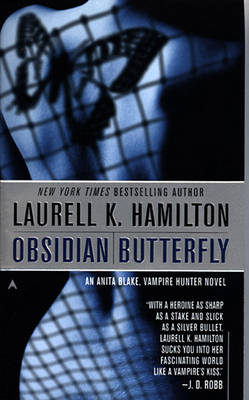In this instalment Anita leaves Richard and Jean-Claude behind in St Louis, and goes to help Edward who she is in debt with. It gives her time to think about what to do with the boys, and to contemplate whether or not she's turning into a monster herself.
I get what Laurell K. Hamilton was going for with Obsidian Butterfly. It's the typical break-novel that every series needs in a while. There were a bit too many characters appearing in the series, and the reader needed a break from them. This book focusses much more on Anita herself, and her dilemmas. If you read this series for Anita, this will be your favourite book, and it is for many people. I don't read the series for Anita, because I think she's arrogant and a complete jerk (especially in the last few books) that happens to kill baddies to feel better about herself. I like the books because they're action-packed and for the social dynamics between all the men we met throughout the series. There was no social dynamics, and the biggest part of Obsidian Butterfly wasn't action-y enough to satisfy me.
The Anita Blake books have always been very explicit violence-wise. The thing that makes many people uncomfortable and often lets them drop the series is how Ms Hamilton combines violence with sex. Most sexual encounters in the books are close to rape. It doesn't happen to Anita herself usually, but she does watch it happen. Ms Hamilton always walks a very fine line with this, and I think she completely crosses that line in Obsidian Butterfly. This book contains graphic mutilation of babies, death of babies, the torturing of a seven-year-old girl, and the rape of a fourteen-year-old boy, people wearing intestines as skirts (literally), descriptions of crime-scenes where the bodies look as if they've been taken through a meat grinder. It was all just too much for me, and I skipped through the baby-part. I think in this book Ms Hamilton went from gore to sick, which is not something I enjoy reading.
It also seemed to me that Obsidian Butterfly was drawn out unnecessarily. My version almost reaches seven-hundred pages, and I felt it could easily have been half the bulk. It's very repetitive, and it's like most of the book is just filled with Anita walking around, thinking she's badass, while provoking every male she meets. At one point she talks about this to someone, saying that by making sexual jokes she becomes "one of the guys". As a girl who has been "one of the guys" for years, objectifying yourself and flirting with them isn't a requirement to get along with them. She made it seem as if you can't be friends with guys without there being sexual innuendos between you. Well, I guess that's the story of Anita's life.
My biggest problem is how offensive this book is in a very sneaky way. For one it's extremely condescending towards women. I can't believe how mistreated about every woman in this series is. Not a single woman gets some respect, except Anita who is a class one ass-hole. I won't get further into this, because this review says it all. Ms Hamilton alienates her audience, especially in this paragraph (which I think should not have been published, ever):
I'd been chunky in junior high, close to fat, so I knew what I was talking about. So that no teenager out there will get the wrong idea and go all anorexic on me, I was a size thirteen in jeans, and that was at five foot nothing. See, I was really chunky. I hate women who complain about being fat when they're like a size five. Anything under a size five isn't a woman. It's a boy with breasts.
Why THANK YOU Ms Hamilton, apparently I'm not WORTHY of being called a women just because I'm a size four? How the hell can I help being petite? If you're concerned about teenagers, you should consider first that many of them will be small, and won't like to be called a frigging boy with breasts. I'm a girl, and proud to be one, thank you very much.
I still have a few Anita's left, but if something like this is said again, I'll quit the series. I don't read books to get called a boy with breasts.
